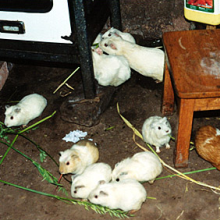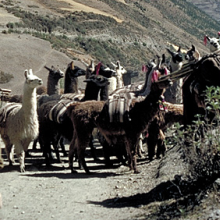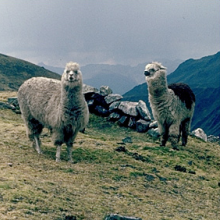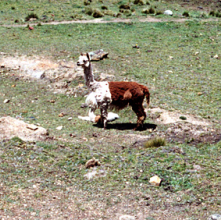explore
Andean Highlands - Animals

Less is known of the early development of wool textiles in the highlands, but there is evidence of a strong tradition of spinning, weaving and dyeing by around 800 B.C.
Other domesticated highland animals were the dog, muscovy duck, and cavy or guinea pig. Guinea pigs were raised throughout the central Andes as a source of meat. Today, they are kept in kitchens and fed table scraps. Because of their high fertility and ease of care, they probably ranked with seafood as the most important sources of meat in the Andean diet, more so than camelids or deer.
Image: Guinea pigs scurry about on a kitchen floor in a home in Chinchero, Cusco.

Both wild and domesticated animals were central to the lives of ancient Andean people. The most important of these were the American camelids. Four species of camelids live in Peru today as in the past: the llama, the alpaca, the guanaco and the vicuña. The llama and alpaca have been exploited for meat, wool, and, in the case of the llama, as a beast of burden, for thousands of years. The guanaco and vicuña are wild and were hunted by the Inka. Some were used for their wool then released, while others were killed and sacrificed for meat and hides.
Image: A caravan of llamas carrying hand-woven bags likely filled with potatoes. Llamas are still important today as beasts of burden, as they were in the past, among the many indigenous peoples of Peru.

The main heartland of the llama population in South America is and was on the altiplano of southern Peru and Bolivia around Lake Titicaca.
Some wild highland mammals are two species of deer, pumas (mountain lions), viscacha (large edible rodents) and spectacled bears. Condors nest in highland peaks.
Image: The condor was a common subject in Andean art. As a master of the skies which preyed upon a great many creatures below, the condor was an important symbol of power. This textile is actually from the coast, not the highlands. Made by the Chimú, this is a very rare example of a condor among pieces from this location and time period. T81.0043

There are many reasons camelids were essential to life for ancient people in the highlands. Camelids can live with little water on the dry, high-altitude grassland. Their silky hair can be easily dyed and used to create the protective garments needed in such a harsh environment. When necessary, camelids can be used as a source of food protein and as a means of transportation. Llamas carried goods from one zone to another, helping the ancient people to exploit multiple ecological zones. The goods were transported in cloth carrying bags made from camelid wool. Textiles made from alpaca wool, and in some cases llama wool, developed in the highlands into brightly-coloured, expertly woven materials, with a different design tradition from the coast.

Llamas
- Used primarily as beasts of burden; can carry 20-40 kg and travel up to 30 km a day.
- Also kept as a source of meat and wool, and for dung production.
- Llama wool is coarser than alpaca wool and is used for household goods, blankets, rugs and ropes.
- Llamas had various roles in ritual.

- Gifts of llamas were made by the state in Inka times to ensure loyalty.
- The Inka encouraged the expansion of llama husbandry throughout the empire.
- Llama caravans were used throughout ancient times to transport goods between the coast and highlands and from north to south.

-
Alpacas
- Smaller and lighter than llamas, kept as wool producers and for meat.
- Less widely distributed, range from central Peru to extreme northern Argentina, rarely occurring below 3700 m.
- Highly dependent on bofedales (succulent pasture lands) found in high wet areas.
- Produce fine silky wool in abundance under the right altitudinal, climatic and pasture conditions.

- During Inka period, alpacas were kept primarily as producers of wool, shorn every three years.
- One of the duties Inka demanded of peasantry was to weave cloth from state-supplied wool. In communities where herds did not exist, wool was stored in state warehouses and distributed to peasant households to be woven for the empire.
- Fine cloth was woven from alpaca wool for use by the elite, and these textiles were among the most highly valued commodities in Peru.